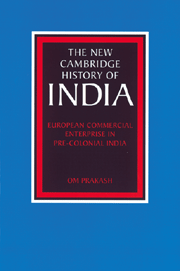Book contents
- Frontmatter
- Dedication
- Contents
- List of figures
- List of maps
- List of tables
- General editor's preface
- Preface
- Introduction
- 1 India in the Indian Ocean trade, circa 1500
- 2 The Portuguese in India, 1500–1640
- 3 The European trading companies: exports from Europe and the generation of purchasing power in Asia
- 4 The companies in India: the politics and the economics of trade
- 5 Euro-Asian and intra-Asian trade: the phase of Dutch domination, 1600–1680
- 6 The VOC and the growing competition by the English and the French, 1680–1740
- 7 The supremacy of the English East India Company, 1740–1800
- 8 European trade and the Indian economy
- 9 Conclusion
- Bibliographic Essay
- Index
- Misc-endmatter
- Map 1 Important trading centres in Asia in the seventeenth and eighteenth centuries"
- Map 2 Portuguese seaborne empire, c. 1580"
- Map 3 The Indian Ocean in the seventeenth and eighteenth centuries, showing the settlements of the English East India Company and of other European nations"
- Map 4 India: main textile–weaving areas, 1600–1750"
- References
8 - European trade and the Indian economy
Published online by Cambridge University Press: 28 March 2008
- Frontmatter
- Dedication
- Contents
- List of figures
- List of maps
- List of tables
- General editor's preface
- Preface
- Introduction
- 1 India in the Indian Ocean trade, circa 1500
- 2 The Portuguese in India, 1500–1640
- 3 The European trading companies: exports from Europe and the generation of purchasing power in Asia
- 4 The companies in India: the politics and the economics of trade
- 5 Euro-Asian and intra-Asian trade: the phase of Dutch domination, 1600–1680
- 6 The VOC and the growing competition by the English and the French, 1680–1740
- 7 The supremacy of the English East India Company, 1740–1800
- 8 European trade and the Indian economy
- 9 Conclusion
- Bibliographic Essay
- Index
- Misc-endmatter
- Map 1 Important trading centres in Asia in the seventeenth and eighteenth centuries"
- Map 2 Portuguese seaborne empire, c. 1580"
- Map 3 The Indian Ocean in the seventeenth and eighteenth centuries, showing the settlements of the English East India Company and of other European nations"
- Map 4 India: main textile–weaving areas, 1600–1750"
- References
Summary
TRADE AS AN INSTRUMENT OF GROWTH
The principal distinguishing feature of Euro-Asian trade in the early modern period was its bullion-based character. In view of the inability of Europe to supply western products with a potential market in Asia at prices that would generate a large enough demand for them to provide the necessary revenue for the purchase of the Asian goods, the Europeans were obliged to import the bulk of the purchasing power they brought to India (and other parts of Asia) in precious metals, mainly silver. It is indeed quite immaterial whether the imported precious metals are treated as a traded commodity or as a balancing item settling trade surpluses. Traditionally, trade between the Indian subcontinent and neighbouring regions such as southeast Asia had essentially been one involving the exchange of commodities such as Indian textiles against items such as Indonesian spices and Malayan tin. But at the same time, trade with other regions such as west Asia had involved the exchange of Indian textiles overwhelmingly against precious metals. It is not without reason that the port of Mocha in the Red Sea was described as the treasure chest of the Mughal empire. The Euro-Asian trade was thus essentially a continuation of the earlier pattern of trade with regions such as west Asia.
In so far as a country is relatively more efficient in the production of export goods than in that of import goods, an increase in trade between nations is ordinarily to the advantage of both the trading partners, involving an increase in the value of the total output in each of the two economies.
- Type
- Chapter
- Information
- European Commercial Enterprise in Pre-Colonial India , pp. 315 - 336Publisher: Cambridge University PressPrint publication year: 1998
References
- 1
- Cited by



